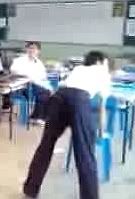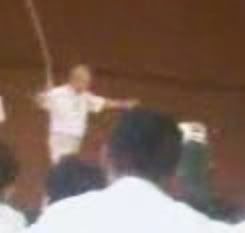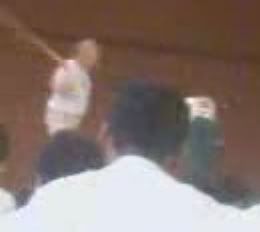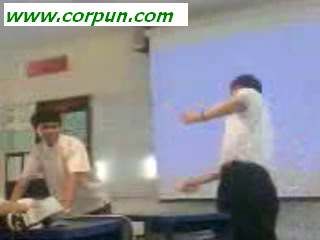
A 17-year-old at one of Singapore's strict all-boys secondary schools demonstrates the stance students must adopt (after emptying their back pockets) when being routinely disciplined in the office: hands holding on to the seat of a chair, feet apart for stability and balance, legs locked straight, posterior pushed a little up and back.
Informed sources indicate that such office canings play a substantial role in this particular school's behaviour management strategy, with the full approval of the Parents' Support Group.
These boys-only schools seem to be popular with parents who seek an especially firmly structured setting for their sons' education. |
|
The following description of the current situation is derived partly from a variety of published materials and partly from information provided privately by local teachers and students.
British-style formal caning (for male students only) is fully lawful as a punishment in Singapore schools and explicitly supported by the government. Now that school corporal punishment has been completely abolished in the UK and most of its other former outposts, Singapore is probably the country where English school caning traditions are still most faithfully upheld. The majority of the country's 150 or so secondary schools use the cane, and at some of them it is a significant element in the disciplinary system.
It is important to be clear that this is something different from the (much more severe) judicial canings -- ordered by the courts, and inflicted in prison, mostly on adult men -- for which Singapore is rather better known.
The Singapore education system is stunningly successful. The country comes at or very close to the top in international comparisons of maths, science and reading achievement (see External links below). It would be absurd to suggest that this is because of corporal punishment: other Asian countries which no longer use it are also high up the lists. But it does show that the use of CP is no barrier to excellence in education, as some would have us believe.
Singapore seems to be the only English-speaking country outside the USA where a significant number of schools state in their own literature or websites that they officially use corporal punishment, as in these examples. However, a few schools do not mention punishment or discipline at all on their websites, so we cannot tell whether they use the cane or not.
As of 2018, about 13% of primary schools, and about 53% of secondary schools (excluding those for girls only), said on their websites that they caned male students.
Three secondary schools formerly stated publicly that they did not use CP. One of them has closed down, and the other two have reversed their policy and now use the cane.
Corporal punishment in government schools is regulated by the Ministry of Education. Details of every caning have to be keyed into the Ministry's computer database. It is to be administered by the principal or under his or her express authority, with another teacher as witness.
Under Ministry guidelines, there is a suggested maximum of three strokes per caning. This was reduced from six strokes in 2017. This change will not have made much difference in practice, since canings of more than three strokes were already fairly rare. The cane is applied to the seat of a boy's school uniform trousers or shorts, typically by a specially designated and trained "Discipline Master", for whom this skilled task is a recognised part of his job description. (Some schools now give them titles like "Head of Student Management" instead.) A big flexible "light rattan" cane is used, with the miscreant bending over a desk or chair. Ministry regulations also permit caning on the hands, but in practice this is rare, at any rate at secondary level.
"Light" is a relative term and, while the school cane is certainly not as heavy and thick as the Singapore judicial cane, photographs show that it is almost as long -- about one metre long.
Although no official statistics appear to be available, anecdotal mentions of canings crop up in newspaper articles, websites and message boards, as well as in conversations with teachers and students, sufficiently often to confirm that they occur quite frequently in many, but not all, Singapore schools -- certainly in most boys' schools, but also for boys in many mixed-sex schools.
Singapore has some 160 secondary schools. These are for pupils aged between 12 and 18, although the majority move on to college by age 17. Fifteen of these schools are for girls only and thus irrelevant for our purposes here, since females may not be caned. There are 12 boys-only secondary schools, several of which are run by various Christian denominations. Informed sources suggest that some of these make fairly extensive use of corporal punishment. Well-known examples are St Patrick's (Catholic), St Gabriel's (Catholic) and St Andrew's (Anglican). The boys-only schools also include some "top" or "elite" academic schools such as Raffles Institution, Victoria School, Hwa Chong Institution, and Anglo-Chinese School (Independent). These, too, use the cane occasionally or at least are known to have done so in recent years.
But it is the 130 or so mixed-sex state schools that form the backbone of the secondary education system. Most of these are mainstream, neighbourhood schools in the country's working-class tower-block heartland, areas rarely seen by the tourists who throng Orchard Road or Boat Quay. They vary greatly in their use of caning.
Most CP is meted out privately in the school office, usually with the principal or vice-principal in attendance. The aim in these cases is simply to show the student that poor behavioural choices have consequences, and that he must take responsibility for his actions, and to supply him with the pain he needs to induce a change of attitude or behaviour.
Schools vary a lot in their attitudes towards parental involvement. Some state uncompromisingly that misbehaving boys will be caned "with or without their parents' consent". The only legal requirement is that parents be informed afterwards. At other schools, parents will sometimes have been consulted by phone beforehand, or even summoned to the school in person to discuss their son's offence and how to respond to it, but they are not generally invited to be present at the actual punishment.
The final decision to cane rests legally with the Principal; but in practice there may be a collective decision by a School Disciplinary Committee, on which the Principal might be joined by the Vice-Principal and the DM(s) and counsellor(s) and probably one or two of the boy's class teachers.
It rarely takes place immediately after the commission of the offence, and certainly not in anger. This careful, calm "due process" approach, together with the hushed solemnity of the infliction itself, gives the whole procedure an altogether different flavour from the sort of slapdash, casual, unregulated, spur-of-the-moment and often bad-tempered use of canes or sticks that is frequently reported in schools in, for instance, the Indian sub-continent or certain African countries, and also referred to, misleadingly in my view, as "corporal punishment".
One criticism of this kind of consultative decision-making is that it all takes time, meaning that several days, or even weeks, might elapse between the offence and the consequence. Some Principals, no doubt taking the view that punishment is most efficacious if it follows on swiftly from the wrongdoing, prefer to act more autocratically.
By their nature, private office canings do not become known to the general public except in exceptional circumstances. One such exceptional case took place in May 2011 at the aforementioned St Andrew's Secondary, where the cane is known anecdotally to be in regular use. The press report describes an entirely routine and unremarkable caning of two boys there -- one stroke each on the buttocks in the Discipline Master's office. Only the unusual nature of the offence -- a public spat on Facebook in which threatening language was used -- explains why this particular punishment got into the papers.
Sometimes it is decided that the student must receive his punishment, more ceremoniously, in a classroom in front of his classmates, as in this video clip. This, generally known as a "class caning", adds a dash of embarrassment to the recipe, and also serves pour encourager les autres. "Class canings" are not to be confused with instant punishment by the class teacher, which is not allowed in Singapore. Ordinary class teachers are not nowadays permitted to use CP, and this rule is actively enforced by the government. Some anecdotal evidence suggests that this was not always the case until maybe the 1980s.
Perhaps uniquely for a first-world country in the 21st century, there are some schools where the punishment ceremony may even, in the most serious or recalcitrant cases, be carried out before an assembly of the whole school, girls as well as boys -- an audience in many instances of some 1,500.
These salutary and humbling "public canings" (so-called -- they are not of course open to the general public), pictured below left, are not as common as they used to be but are still said to occur at a few schools, where there might be several such occasions per year, sometimes involving as many as half a dozen boys being dealt with in succession at the one ceremony. In some cases, each offender has to read out a pre-agreed "public apology" from the stage just before taking up his position across the punishment desk.
After the strokes have been administered, he may have to remain on stage while the Principal harangues the school about his misdemeanours. Where the school is a Christian one (of which there are perhaps 20, not counting several all-girls ones), there may also be a short blessing of the proceedings by the Chaplain.
An example was reported in the press in this Sep 2005 case at an unnamed "top boys' school" (swiftly identified in local message boards as Raffles Institution), and this Oct 2004 case at Bowen Secondary, in which three 17-year-olds were caned in public after the Head Prefect failed to persuade the principal that private canings would suffice.
This June 1999 case, where six senior students together received two strokes each on their buttocks with a "thick and long" cane in front of the assembled school at Pioneer Secondary, was unusual, both in that one of the boys is named, and in that his parents made a rare public protest about it. Interestingly, this was claimed to be the first public caning at the school in five years. The few cases that get into the newspapers are, by definition, likely to be untypical.
Public caning is unlikely to befall a boy who has not already undergone office canings or class canings on previous occasions. It universalises the deterrent effect of the punishment for other students, with a dramatic illustration that there are clear limits to what is behaviourally acceptable. And it maximises retribution for the offender in the form of shame as well as pain.

Scenes from a typical "public caning" session, one of several held at this co-educational neighbourhood school in July 2008. Three 15/16-year-olds had to undergo two strokes each in front of over 1,000 girls and boys. They had been found smoking in the school toilets.
Here, one of the culprits (in white shirt and dark trousers) has been made to bend at almost 90 degrees over a desk or chair placed specially on the stage. He will have his elbows on the desk, or his hands on the seat of the chair, with his head well down, so that his upper back is near horizontal. He will already be suffering at this point, having received his first stroke, and now awaits the second.
At this school, the custom is for the boy being punished to have his bottom pointing at the audience so they are obliged to watch the cane landing. (At many other schools, the offender faces the assembly, as in these video clips -- which may be more embarrassing for him, as the audience will see all his involuntary facial expressions.)
The Discipline Master ("DM"), on the left, takes careful aim. If you look closely (just above the right ear of the audience member partly obscuring the view) you can see that he is positioning the business end of the cane horizontally across the centre of the bending boy's behind, with its tip reaching exactly as far as the right-hand side of the far buttock.
The teacher glimpsed on the right is assisting the operation by preparing each offender in turn for punishment: helping him to bend over properly, checking there are no extra pairs of underwear, smoothing the trouser cloth snugly over the whole target area to ensure that there are no folds or rucks to impede the cane's impact, and fixing a magazine over the small of the back to protect the spine.

The Singapore secondary school cane is big -- about one metre long. The longer the cane, the sharper the pain, but also the more skill and expertise it takes to control it accurately. DMs get special training from the Ministry of Education, and regular practice. Above, the DM pulls the cane back and up, ready for the next stroke.
This particular DM believes in wasting no time between strokes. Others prefer to give the student time to recover his composure after each one.
Some DMs (at any rate for office canings -- probably not at the more solemn ritual of the public caning) even allow the young man to jump up and down rubbing the affected part before bending over again for the next stroke.

The camera captures the cane in mid-descent. The DM has his left arm outstretched for balance, hidden from view in this shot. This DM's acrobatics are quite sedate: some go through all sorts of martial-arts-type moves as they make their approach.

The rattan is moving too fast to be caught on camera as it swishes through the last part of its trajectory and smacks resoundingly into the waiting student's rear end (the sheer volume of the sound always takes novice onlookers by surprise). The impressive amount of vigour and energy the DM puts into wielding it can be seen from his posture in these successive frames.

His two strokes duly received, the student will now be in some pain. He has been helped up and is turning to his left to move aside, making way for the next wrongdoer (out of picture on the right) to come forward and go over the punishment desk.
At left, the school's lady Principal watches the proceedings. She will have been the key figure in deciding to hold this disciplinary session in front of the whole school, and will have agreed with the DM how many strokes to give each boy. She will probably make a speech to the assembled company -- in this case, no doubt, about the evils of tobacco use -- once all the day's canings have been inflicted.
|
|
There can be intermediate levels between a "class caning" and a "public caning". Some schools give these special names, such as "a cohort caning" (in front of all classes of the offending pupil's year) and "a consortium caning" (in front of all the lower secondary, or all the upper secondary, or certain streams of classes within certain year levels).
The handful of boys-only secondary schools tend, by all accounts, to be even stricter than the mainstream mixed-sex schools. Office canings at some of them, with parental support, are said to be more or less a daily event (see box above right), routinely imposed for infractions that in most schools would probably attract only a detention, like latecoming, forgetting books, or wearing the wrong colour of socks.
At the more mainstream schools, however, the offences most often punished corporally are smoking, fighting/bullying, truancy and defiance. Other activities likely to result in posterial discipline include vandalism, cheating and stealing.
Of these, smoking is perhaps the single most common misdemeanour. Many schools cane automatically for it, and this includes smoking anywhere in Singapore in school uniform, as well as at school. Smoking under the age of 18 (increased to 21 in 2021), in or out of uniform, is actually a criminal offence, and when the police pick up such a malefactor they will inform his school as a matter of course. Students in these cases are also reported to the Health Sciences Authority, which can require them to enrol on a compulsory stop-smoking course or else pay a large fine, as well as (if male) being caned at school if they were in uniform at the time.
which can require them to enrol on a compulsory stop-smoking course or else pay a large fine, as well as (if male) being caned at school if they were in uniform at the time.
Quite a few schools also operate a merit/demerit points system for lesser offences, under which a boy will automatically be asked to report to the office for a caning upon reaching a specified number of demerits. These policies are sometimes set out in detail in school handbooks.
Students undergoing corporal punishment at secondary schools may be aged anything from 12 to 18 inclusive. 18 is rare, simply because most students have left by then. 17 is not so uncommon, as we shall see. But the great majority of canings are of boys aged 14, 15 and 16.
In some cases CP is combined with suspension, typically for a week. If the culprit is lucky, he is allowed to take his strokes before going home to start his suspension. If not, he will be caned on the day of his return to school, so he has all week to "look forward" to his impending ordeal.
From accounts by students who have been caned, it appears that the recipient typically suffers moderate to acute pain for a few minutes, depending above all on the number of strokes received. This soon gives way to a less intense stinging and itching sensation around the points of impact, together with a more generalised aching or soreness which usually lasts for at least several hours, during which time sitting down is likely to be uncomfortable.
Across the young man's buttocks will appear neat horizontal weals or "tramlines", one set for each stroke received, lasting for some days, and he may also be bruised for a week or more. These effects are only superficial: the "light rattan" will not cut deep into the flesh in the way that the much heavier judicial cane does.
In the hope of saving face, most boys try not to give vocal expression to their pain when the cane makes contact; but many fail in this endeavour. According to experienced insiders, a wordless, semi-stifled yelp or groan is most often heard, as in the video clip mentioned above.
Rapid gasps of breath and watery eyes are also normal during the actual infliction and for a couple of minutes afterwards. Actual weeping is fairly rare, Singapore being very much a "big boys don't cry" kind of society. Especially at a public caning, feigning nonchalance ("act brave", in the local slang) is de rigueur.
Different schools have different detailed policies. One or two make the offender change into PE kit for his caning. Some DMs take either an elaborate run-up, a "flying leap", or a kind of twirling dance, as they administer each stroke. Some will pull the boy's shirt out of his trousers before bending him over. Some schools designate a muscular young PE teacher as the DM (an echo of some American practice). At one or two schools, the Principal (or Vice-Principal, if the Principal is female) takes on the role of DM himself. Conversely, some huge schools have so much discipline business to conduct that they have two or more full-time DMs, who might share out the caning work between them. Some conduct public canings outdoors on the parade square, others inside in the hall.
Many schools protect the culprit's spine with a cushion, or a book, or a document file, or a slab of cardboard, or a special wide leather belt, placed just above the target area, though this really isn't necessary if a proper position is assumed, and it is done primarily, I think, for dramatic effect. Where several strokes have to be administered, some DMs deliver them all in brisk succession, others wait after each one until the boy signals that he feels able to take the next one. At least one school, where a group of students are receiving a number of strokes each, will give one stroke to each boy in turn and then start again with the second stroke for each boy, and so on. Some schools cane in the corridor outside the classroom rather than inside the room. One or two have been known to let boys negotiate on an ad hoc basis for a cane stroke in lieu of multiple detentions, though in general there is no tradition of "choosing your punishment" as in some US paddling schools. Many schools require the student to receive counselling before and/or after his caning (this is a Ministry of Education recommendation).
Broadly speaking, though, the whole process is rather similar to much pre-1998 experience in the UK, especially at English boys' secondary schools up to the 1980s. This may be because of a strong British input to the education system while Singapore was developing rapidly in the 1950s and 1960s. Also, modern Singapore's founding father, Lee Kwan Yew, made explicit his approval of corporal punishment -- specifically, English-style caning applied vigorously to the buttocks -- as being much the best way of disciplining errant young men.(1) (He also introduced similar procedures for disobedient teenage military conscripts.)
Some primary schools (for ages 6 through 12) in Singapore also sometimes provide CP for boys who need it, but generally less severely and probably with a smaller cane.
Singapore's 22 government-supported Junior Colleges (JCs), roughly the equivalent of British 6th-form colleges, at which students are normally aged 16+ to 19, do not currently feature CP in their schedules of penalties, as far as can be ascertained, though there is no legal reason why they should not: full adulthood is not reached until age 21 in Singapore. Indeed, the relevant legislation (s.88 of the Education (Schools) Regulations) explicitly lays down that the corporal punishment provisions apply to Junior Colleges as well as secondary schools.
UPDATE: One Junior College -- St Andrew's JC -- does now (2023) list "Caning" as a punishment in its Student Handbook. As far as can be ascertained, this is the first time in several decades that a JC has stated publicly that it will actually apply corporal punishment if required.
At least two junior colleges are on the public record as having used caning in the past.(2) Thus, if a boy moves on to Junior College shortly before he is 17, he is probably free of the risk of a caning, whereas his contemporary who stays on at secondary school for at least one more year in "secondary 5" -- typically to take GCE 'O' levels after being in a slower stream -- remains subject to it.
For instance, one school caned no fewer than five 17-year-olds at one go in April 2008, according to informed sources. All five had been playing truant, and were required to take turns to bend over for two serious strokes each in front of their mixed-sex secondary 5 class -- highly embarrassing as well as painful. Recent cases at other schools are known to have involved three-stroke office canings of students aged just under 18, for fighting and gambling. The only viable alternative punishment for such serious offences -- suspension -- could be a disaster for students preparing for their crucial last-chance final exams.
Back to those Ministry rules: no implement other than a cane may be used, and ordinary classroom teachers are not allowed to use CP of any kind: even spanking with the open hand is absolutely forbidden. This helps to ensure that CP is never administered in anger and does not degenerate into a casual, on-the-spot penalty for low-level misbehaviour in class, but is instead considered by the school's senior management in each case, is delivered safely and accurately by a dispassionate expert, and is -- with a few exceptions, notably some of the boys-only schools -- generally reserved for those transgressions regarded in the local culture as relatively serious.
It is clear, though, that caning is far from being a "last resort" (to use the silly phrase that came to bedevil the question of school CP in Britain), even though at least one official source claims that it is. At most Singapore schools the cane tends to come after detention, but before suspension, in the hierarchy of penalties -- although, as noted earlier, it is also quite common for caning and suspension, or caning and detention, to be combined. The actual last resort, of course, is expulsion.
Yet there is at least one famously strict school where if a boy has to be expelled he is actually publicly caned as well, in some cases deploying the rarely-invoked maximum (as it was at the time) of six strokes -- a severe punishment indeed. One wonders why the student in such a case agrees to turn up and submit to this, since he is being kicked out of the school anyway. But they do. Perhaps it is made a condition of not turning the matter over to the police.
Occasionally the suggestion is raised in the public prints that CP be extended to girl students, who have been seen in some quarters as getting out of hand. Teachers' representatives have backed this idea in the past (see External links, below). But the government has firmly resisted it, pointing out that serious offences by girls are a small fraction of the total. In any case, the idea doesn't ring true with most people at an emotional level, because corporal punishment, and particularly caning on the buttocks, has always been seen throughout the British world as overwhelmingly "a guy thing", as well as being arguably unsuited to the female physiology. And Singapore schoolboys themselves, in my experience, are among the last people to challenge the notion that males and females are different species. It does not seem to strike most of them as unfair that they might be caned while girls never will be. This is all of a piece with, for instance, the fact that all male Singaporeans, but no women, have to perform military service.
"Public caning" is noticeably more controversial in local opinion than corporal punishment per se. In particular, in some quarters there has been a concern that it can be upsetting for younger girls to have to witness it. One or two schools do allow girls to leave the hall before the caning begins, if they wish, according to informed sources.
But there is little evidence of pressure to abolish the cane altogether. Opposition political parties say they favour retaining it. It makes a good fit with Singapore's highly "masculine" vision of itself as a brave, tough, resilient, militarised society, much as Britain used to be but is no longer. There seems to be wide acceptance that caning is a fair and effective penalty, particularly for wayward schoolboys in the middle teens, and helps to maintain the enviably high levels of school discipline and educational achievement on which visitors to Singapore so often remark.
(1) See e.g. his autobiography, the relevant section of which you can read here. He described his own caning at the (then as now) elite Raffles Institution in the 1930s. Raffles was still caning in 2005 and still in 2011, according to informed sources.
He described his own caning at the (then as now) elite Raffles Institution in the 1930s. Raffles was still caning in 2005 and still in 2011, according to informed sources.
(2) These are, firstly, Anglo-Chinese Junior College (ACJC), in the 1980s. See Chee Keng Lim, in Development of Education in Singapore, National Archives of Singapore No 1425. See also this Feb 1987 news item on an incident that resulted in seven ACJC students being caned. And secondly, anecdotally, Catholic Junior College in the late 1970s: see page 103 of this book.
DOCUMENTS:
School caning
Regulation No 88 under the Schools Regulation Act 1957
School Principals' Handbook, Section 19.3 - Corporal punishment
EXTERNAL LINKS: (these will open in a new window) 
Caning in Singapore: Judicial, School & Parental Corporal Punishment
2019 document from a group of local lawyers. This clarifies some of the Ministry of Education guidelines on school caning.
Dilemmas or no dilemmas: The role and experience of eleven counsellors working in the Singapore secondary school system.
The education ministry recommends that all disciplinary cases involving corporal punishment be followed up with counselling. This 2008 university thesis explores the practicalities of this idea.
Restorative justice as a disciplinary tool: A perspective from Singapore
Academic research (2014) into two secondary schools in Singapore which have adopted versions of "restorative justice" as part of their disciplinary framework, but which also continue to provide male students with canings in suitable cases. Are these two approaches compatible, and how does it work in practice?
Care and Control: On the Relationship between Discipline and Counselling in Education
National University of Singapore paper (2002) explains that discipline, including corporal punishment, is not incompatible with school counselling: rather, the two complement each other. "Both are motivated by care and concern for the well-being of the recipient." Indeed, it is recommended that caning be followed up with counselling, to clear the air and help the punished student reflect upon his misbehaviour.
International Student Achievement in Reading
International Student Achievement in Mathematics
International Student Achievement in Science
World-scale objective documentation of different countries' educational achievements, showing that Singapore is doing much better than most countries on the key indicators. This makes nonsense of claims by anti-CP campaigners that the use of corporal punishment somehow runs counter to school success. Clearly there is no relationship at all between the two things. It is the quality of the teaching that matters.
Disciplinary Efforts in Schools
This 2005 official note does not mention CP specifically, but states that since 1999 Singapore schools have had Operations Managers (OMs), who are former police or army officers, to assist Discipline Masters (DMs) in maintaining discipline. Both OMs and DMs get special skills training from the Ministry of Education. See also these May 1999 news items.
Discipline in School
Statement (2005) by the Singapore Teachers' Union. They were concerned about indiscipline by girls, who by law cannot be caned, and asked either that that law be changed (which didn't happen) or that some other steps be taken to deal effectively with defiant and disruptive female students.
Speech by the Education Minister, May 2004
The Minister noted (para 14) that school discipline in Singapore was not getting worse, and indeed that fewer serious school offences were being recorded than 15 years earlier. He was confident that discipline was far better in Singapore than in most other countries (this is almost certainly true, on any conceivable measure). And he pointed out rather undiplomatically that, not only in Western countries but even in Japan and Hong Kong (countries where school CP is no longer permitted), violent bullying was rampant in schools, which was not widely the case in Singapore. Although he did not spell this out in words of one syllable, one can read the intended message: countries that have abolished CP have much worse school discipline. At para 16 he made it clear that the government was committed to maintaining high standards of discipline and that it had no plans to change the present rules that allow school principals discretion to use the cane.
See also:
 More photographs of Singapore school canings in Picture Parade
More photographs of Singapore school canings in Picture Parade
 Video clips of Singapore school canings
Video clips of Singapore school canings
 Current Singapore school handbooks
Current Singapore school handbooks
 Other external links for Singapore/School CP
Other external links for Singapore/School CP


